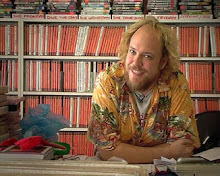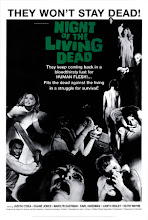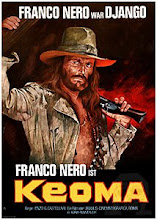
Schlock Treatment's End Of Innocence: Classroom Scare Films 1950-1982
Howdy, Schlock Brothers and Sisters, and welcome to an edition of Schlock Treatment that takes you right the way back to the horrors of the classroom, where formative minds were being twisted and warped by the flickering light of the school's 16mm projector. We've curated a special program of brainwash films designed to scare the crap out of you into becoming good, responsible and clean-living citizens. It's never too late, we add with optimism, and present to you six classics of each genre - the etiquette, anti-drug, VD scare and Stranger Danger film - in a program called "Schlock Treatment's End Of Innocence".
Did you ever wonder where Mike Patton's band Mr Bungle got their name? It was from Beginning Responsibility: Lunchroom Manners (Coronet Films, 1950), a classic of the brainwashing genre from Coronet Films aimed at early primary school kids to teach them lunch room etiquette. Mr Bungle is a Punch-like puppet in a classroom morality play - he knocks over food, is boorish and scruffy, and no-one likes him. NO-ONE should want to be like Mr Bungle. The lunch bell then rings and the kids file out one by one, terrified of being mistaken for the puppet. Dutifully they comb their hair, wait in line, drink their milk - since NO-ONE wants to be like Mr Bungle. I swear I've never seen a larger group of fair-haired, buzzcut automatons outside of the Hitler Youth scene in Cabaret (1972); there are no fat kids - presumably they're in the meatloaf along with that Silverstein boy - and the dark-hairs are misfits or working lunchroom drones. If these kids didn't grow up to be Neo-Cons or dead at forty from an ayneurism from being so goddamned fearful and anal, I swear I'll eat that Silverstein meatloaf.
For the pre-brainwashed teen, Coronet Films comes up with What Makes A Good Party (Coronet Films, 1950), also from 1950, aimed presumably at senior girls during Home Economics class. A trio of high school girls plan a gathering to introduce a college boy to their "gang". First they work out who's in and who's out - "Margie's lots of fun, the fellas will LIKE her" - then they plan the gathering to the minutest detail. According to Coronet, even spontaneous happenings must correspond to a carefully prepared program designed to reinforce a herd mentality. It's FUN, people, and what can be more fun that watching a pack of privileged white kids crowded around a piano singing a minstrel tune. Thus putting the Crack - as in "Cracker" - in "Jimmy Crack Corn". Peachy.
Keep Off The Grass (Sid David Productions, 1969) is a typical Sid Davis propaganda piece that tackles the Generation Gap, and only succeeds in making EVERYone involved looking foolish. Tom is a typical high school senior from 1969: he's hip, he's tried grass a few times, and can't see anything wrong with getting high. After all, the Older Generation smoke cigarettes, and get stoned all the time on alcohol, and they're DANGEROUS drugs. Mom stumbles on Tom's stash and immediately he's sent for a talk with his scotch-guzzling, cigarette-huffing old man (played by a hilariously stone-faced Al Checco, the gruff studio boss in Peter Sellers' The Party [1968]). He lays it on the line for his son - find out the "truth" about pot, and if it's really cool, then toke away. Still looking natty in his sweater and slacks, Tom goes on a half-baked odyssey through Sixties stoner culture looking for the answers, and instead finds self-centred assholes, clowns, bums, delusional non-talents and the word "psychedelicatessen" on one side of the Generation Gap, and helpful cops doing a swell job on the other. It's a trip, alright, but into an alternate universe in which the Joe Patrolman is the hero and hippies sell pot to primary school kids. And what effect is this pot, Mary Jane, grass, weed, whatever you want to call it, really having on our Lost Generation, other than making them look like they're having TOO good a time? We don't know, and we still don't know, so just...DON'T. Just in case, DON'T. Then light up a Camel, down another three or four scotch on the rocks, and shut the hell up.
From hippies to the Beat Generation, we find we're still in Squaresville, Daddy-O, for an microscopic examination of the Wages of Sin (or, as we prefer to call them at Schlock Treatment, the Wages of Fun). Unlike many VD scare films from the period aimed at college kids or servicemen, The Innocent Party (Centron Films; dir. Herk Harvey, 1959) from 1959 comes screaming into the high school classroom, courtesy of the Kansas State Board of Health. To the strains of that Devil's muzak, Be-bop, suburban kids Don (Harper Barnes) and Nicky (Larry Sneegas) get lucky with a pair of "city girls" - you know, jazzbots with too much makeup and that predatory look in their eyes. Don, however, is going steady with "nice girl" Betty (Sandra Hopkins), and after a high school party they accidentally go all the way, to their collective shame. The forever-soiled Backseat Betty now can't look him in the eye, but Don has other problems, like a sore in his jockstrap that just won't go away. The kindly high school's Doctor (Shelby Storck) shows the inevitable deluge of pustules, buboes and syphilis-riddled infants, but is more interested in the names and addresses of every girl he's ever slept with, so they too can get the slideshow and furrowed-brow treatment. The Innocent Party may hold a message of hope for those who are treated in time, but at the cost of society's eternal moral condemnation. Hell, it worked on me, and I swear I'll never listen to jazz again.
"Scare tactics" take on a new dimension with the 1964 horrorshow The Child Molester, a stranger danger film for both parents and their young children from the Highway Safety Foundation. It uses the same sledgehammer techniques used to frighten the bejeezus out of high school drivers, but instead of fishing real dead teens out of smashed-up cars, it's real dead pre-teens out of ponds. Two young girls, Jeannie and Mary, make the old-chestnut mistake of taking sweets from a stranger, then accepting a ride to get more all-day suckers. While the neighbours turn a blind eye and the parents assume their kids are having a coke (the malt shop owner shakes their head) or at the library ("Nooooooo," the librarian silently mouths), the two girls are in the woods locked in a horrifying cat-and-mouse game with the Child Molester, a young respectable looking man miles from the pervert-in-the-dirty-mac cliche. "What does a child molester look like," asks the narrator solemnly. "Do they have sinister faces?" They could be in every back alley or park bench, and look like anyone...INCLUDING YOU. As for who's to blame for the plethora of images of dead children from the Police Department's private stash - well, it's laid firmly on those people for NOT being busybodies, and on parents for not scaring the crap out of their kids about the sweet-carrying Boogeyman. And, after the truly haunting final images of The Child Molester, we sincerely believe this will help.
And so to our final film, a slight change of pace with Ghost Rider (Pennsylvania State University; dir. Chuck Ungar, 1982). Kevin's a new kid in school, fresh from
And there you have it - six ways to screw you up as a child, in the name of social engineering. There goes our rosy vision of childhood forever, as we proudly present the End of Innocence, Schlock Treatment style.

































































































No comments:
Post a Comment